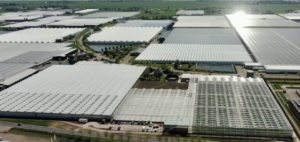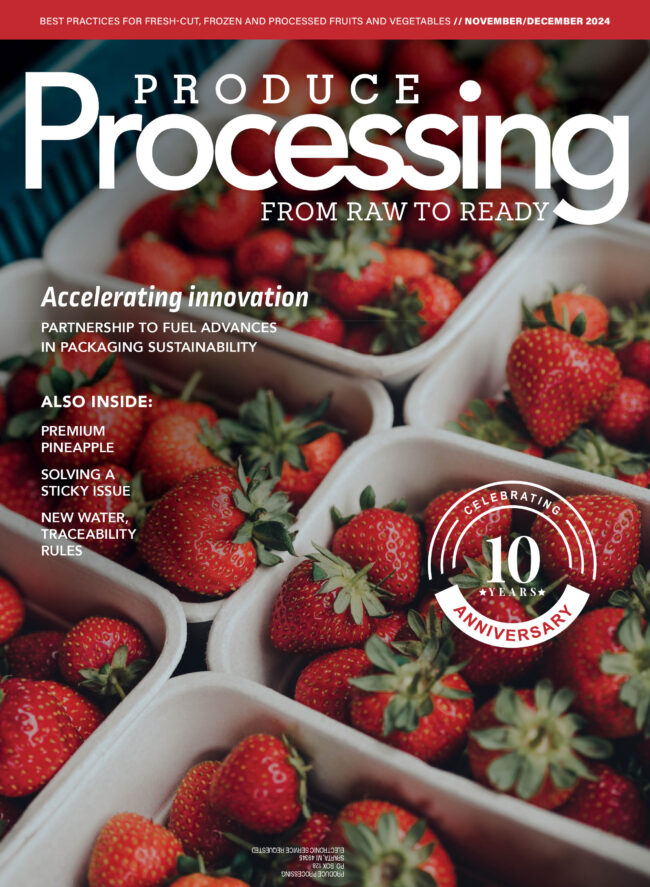Syngenta opens next-generation tomato breeding facility in the Netherlands
In mid-2020, Syngenta presented a webcast tour and interviews at Tomato Vision, an avant-garde tomato greenhouse in the Netherlands’ Maasland.
The company, a giant in the specialty crop agriculture space, said the 150,000-square-foot greenhouse would change the way tomatoes are bred, benefiting growers across the Americas. Syngenta breeders — whose dark-purple Yoom tomato took home the Gold Award at the 2020 Fruit Logistica Innovation Awards — are able to simultaneously test 800 unique new hybrids at the new facility.
The greenhouse was designed to mimic real growing conditions, featuring different sections for lit and unlit cultivation with complete climate control. Tomato Vision will allow the breeding of more high-performance tomato varieties, said Jeroen Iprenburg, technical sales representative for active greenhouse crops at Syngenta. The tomato breeding program at Tomato Vision runs the full spectrum from actively heated or lighted greenhouses to passive high-tech growing systems, and the company is also involved in breeding for field-grown tomatoes. Besides Yoom, other standout Syngenta variety offerings include Duelle, a red grape tomato; Ivorymoon, a pale grape tomato; Climono, a large-fruited tomato-on-the-vine.

“The genetics for our Active Greenhouse portfolio are bred in the Netherlands,” Iprenburg said. “The climatic conditions and environment are comparable to those in the northern USA States and along the Canadian border, where a large part of the USA greenhouse cultivation is concentrated. Our Dutch breeding program produces experimental hybrids which are evaluated with local growers for their suitability in the various markets and environments. As such we don’t have such specific breeding greenhouses in the U.S. or Canada. Syngenta’s breeding operations in Mexico serve the local greenhouse acreage there as well as the growing conditions in southern USA states. In addition, we do have extensive research and development facilities in the USA for many other crops.”
A digital experience — for now
Tomato Vision was designed to be a sort of a tomato growers’ Mecca, for Syngenta to meet directly with their customers and explain the tomato varieties in their portfolio, which are the result of 20 breeding programs around the world.
A colorful tomato mural adorns the entryway, and a room off the entryway is set up for events or displays, where customers can try out some of the new varieties. Within the larger greenhouse, a 16,000-square-foot section is open to visitors, offering them a unique first insight into upcoming introductions, along with a deeper understanding of the entire active greenhouse portfolio from Syngenta.
And although COVID-19 dampened travel plans throughout the industry, Syngenta has been creative in engaging clients digitally. Ruud Kaagman, global tomato crop unit head at Syngenta, in late May led a webcast tour of the spaces, interviewing colleagues and demonstrating how the facility worked.
“By creating this connection between our breeders and the market, we are able to deliver fine-tuned varieties,” he said.
Iprenburg said the reaction from U.S. growers was positive.
“We had hoped to invite many visitors on-site for the opening but we had to be proactive and creative with a virtual event,” he said.
That sort of creative digital engagement will be ongoing at Tomato Vision. During the virtual tour, Kaagman highlighted the group’s ability to virtually take customers into the greenhouse through a virtual reality technology. The breeder in the Tomato Greenhouse wears a headset that relays video and information to the customer’s remote location.
“Many of our North American customers, often together with their retail customers, would visit the Syngenta variety demonstrations several times per year,” Iprenburg said. “In the “new normal” we will be offering these visits online to groups and individuals.”
Those interactions will allow international collaboration and cooperation in the industry to continue during COVID-19.
“There are close connections between our markets and the European continent with regular exchanges on technology, genetics, product development and of course exports of fresh produce. Our European colleagues are very involved and supportive of the developments in the USA and Canada.”
There are many more breeding programs in Syngenta’s worldwide portfolio that address various types of tomato crops, including open-field tomatoes.







